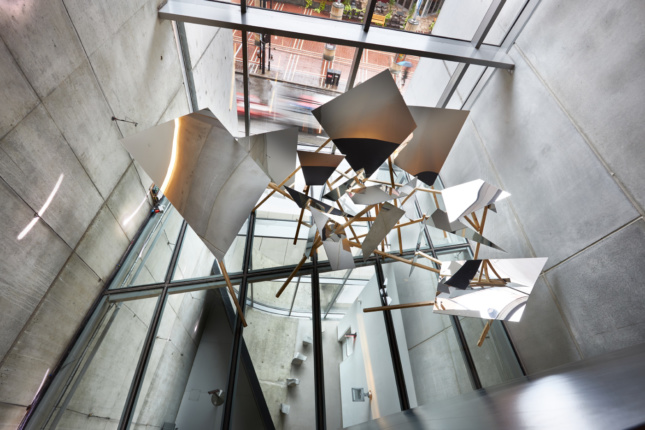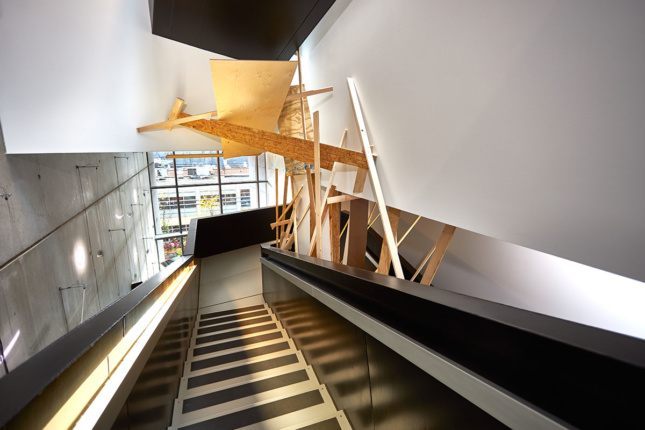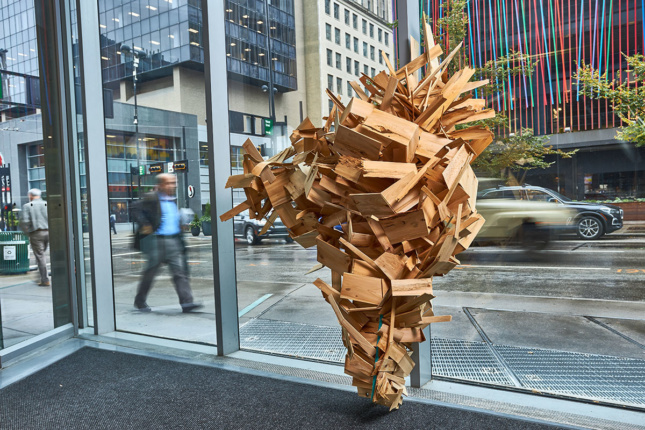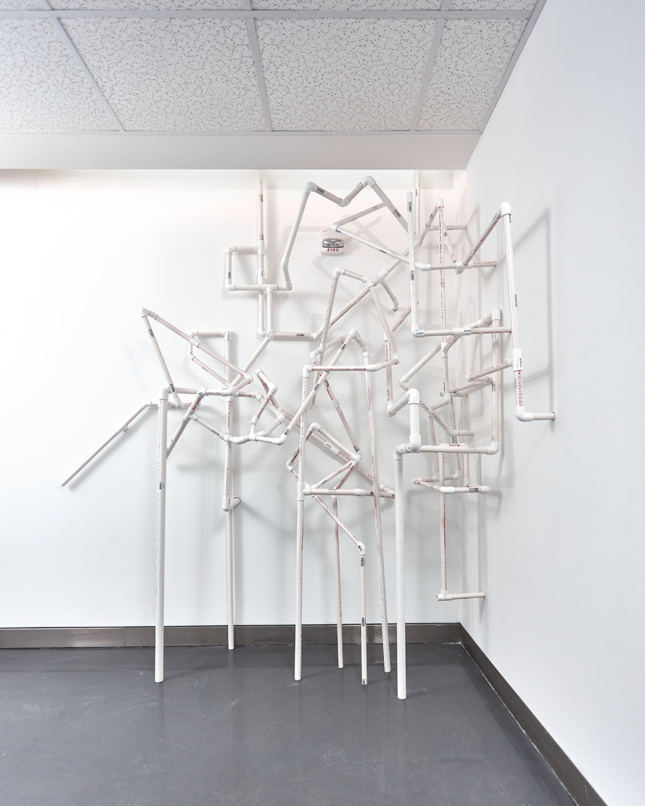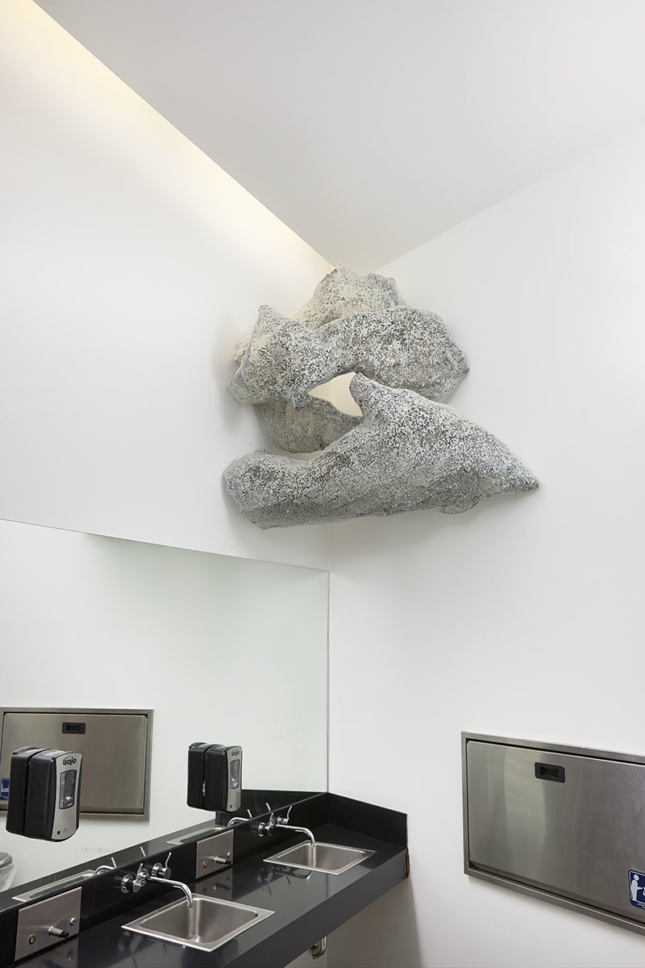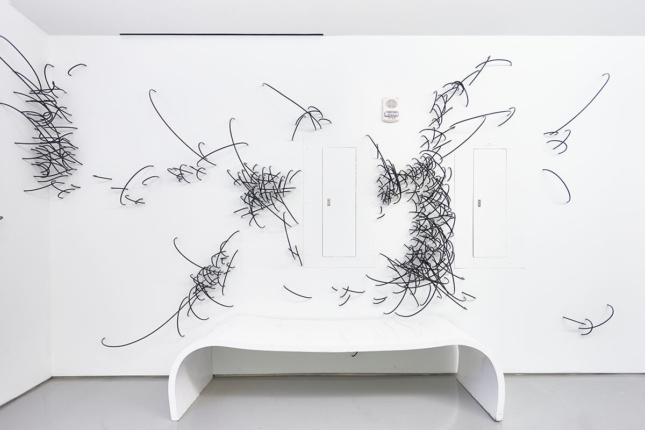Nearly two decades ago, Zaha Hadid‘s vision for a building that housed art, but more broadly worked to catalyze an urban redevelopment effort in Cincinnati, was to create a structure that made art accessible to the public. She delivered on her goal as a spatially complex series of stacked galleries piled up high over a tight infill site. Accentuated on the ground level by virtually no threshold between the city and institution, Hadid’s Contemporary Arts Center (CAC) has since become defined by it’s airy public lobby, an “urban carpet” that transitions seamlessly from sidewalk floor to gallery wall, and Corbusier-inspired stairways that form a vertical street, tapping into a set of galleries floating seemingly impossibly overhead. It is only fitting that a show like Props could emerge in a space that set out to reimagine the idea of what a white box gallery could be.
Props is a set of eight experimental sculptures from architecture-trained mixed media artist Lauren Henkin, who has found new productive uses for underutilized space in the 16-year-old building. Her solo exhibition joins two other compatible shows concerned with spatial awareness: Confinement: Politics of Space and Bodies, and Cincinnati-based photographer Tom Schiff’s Surrounded by Art. The trio of exhibitions will remain open through March 1, 2020.
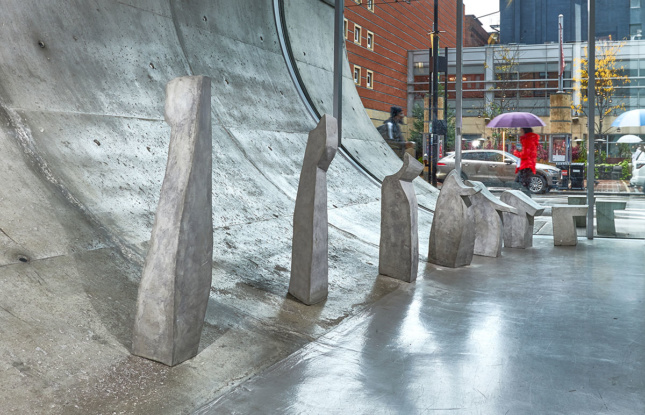
Steven Matijcio, former curator of the CAC, and the current director & chief curator at the Blaffer Art Museum at the University of Houston curated the work. “Lauren [Henkin] and I wanted to challenge and expand the typical locations of artistic presentation at the CAC,” said Matijcio. “By its very nature, Lauren’s series of “Props” was meant to skew the habits, conventions, and assignments that coalesce in even the most avant-garde of structures.”
Each of Henkin’s Props is assembled from an ad hoc material palette—concrete, PVC, wiring cable, plaster scraps, and so on. In one case, scrap wood was pulled from the CAC’s basement and piles of debris discarded by installers of the concurrent exhibitions. The development of the work relied heavily on photographic documentation, drawing, and visits to the building. Henkin worked between her Maine-based studio, the CAC, and a nearby Kentucky-based fabrication studio.
Props intentionally undermines the programming of the CAC’s formal gallery spaces. Why have work in the gallery when it can exist outside of the gallery? Lacking any formalized infrastructure for art viewing (lights, art labels, etc.), the work feels at home amid and within the architecture of the building. The pieces dissolve into walls, hug corners, and playfully grow out from the floor. In this regard, the Props do not come off as menacing or insulting in any way. Instead, they feel like discreet, optimistically friendly characters, producing compelling moments of their own that stop us in our tracks. With no labels or signage, there seems to be a real possibility that some of these Props could be overlooked during de-installation and hang around the museum indefinitely.
Henkin, whose background is in architecture, says movement is the organizational force underlying Props: “These pieces are meant to be viewed while in motion where the viewer is moving up and around the work.” Henkin flips our traditional relationship to art: the work becomes static, while the viewer is set in motion. However, beyond Zaha’s stair, Props can be spotted hiding out in spaces less trafficked, like the entrance to the fourth-floor women’s restroom or a forgotten corner of a hall leading to a fire stair.
Formalized art galleries offer no escape for visitors who become immediately incorporated into the spatial logic of the institution: you must walk up these stairs, and you must view the work in this order. Henkin, Matijcio, and co. offer an alternative to this. You inevitably pass Henkin’s work, but it operates as a filter, or primer, for the other work in the galleries. “The element of play, whimsy, and revelry played an important role in the conception and execution of the project. Lauren’s sculptural interventions in the CAC are meant to disorient and befuddle, and provoke,” said Matijcio. “Some are imposing and seemingly precarious; others are quizzical and slightly comical. Each one is different, but the unifying thread was to reimagine the structure’s non-gallery spaces as fertile terrain to reconsider and activate.”
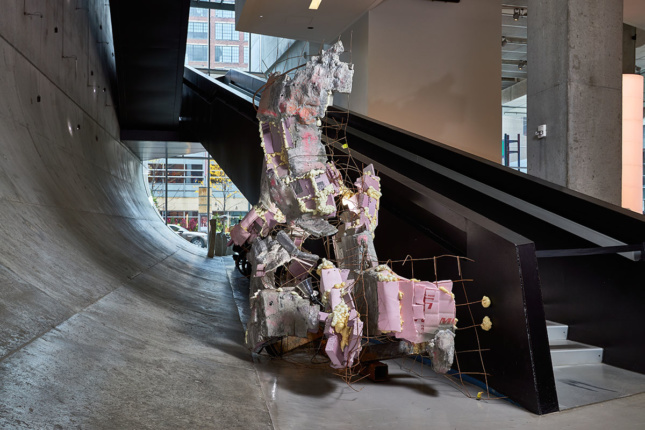
While this iteration of Henkin’s Props likely won’t travel elsewhere due to its site-specificity, the show might still have a legacy. The problem that Henkin’s show exposes is that austere, raw, underutilized display and circulation spaces of today’s art museum do have the opportunity to be more critically used. What would it look like for an exhibition to spill out into these spaces? What trouble would this cause, between issues of security, lighting, and liability? However, what opportunities this could create, to reimagine the broader curatorial flow to the institution! Props beg us to consider and reinvent our normative, intuitive, choreographed movements through the museum, especially in Cincinnati, where 16 years of exhibitions have begun to familiarize and dull this incredibly significant architectural space.
In an institution that prides itself as a “non-collecting” contemporary museum showing “work of the last five minutes,” Props exist as a welcome sideshow to the CAC’s ongoing spirited circus of traveling acts. Henkin reminds us that a white room can fit only so many paintings before overflowing.






